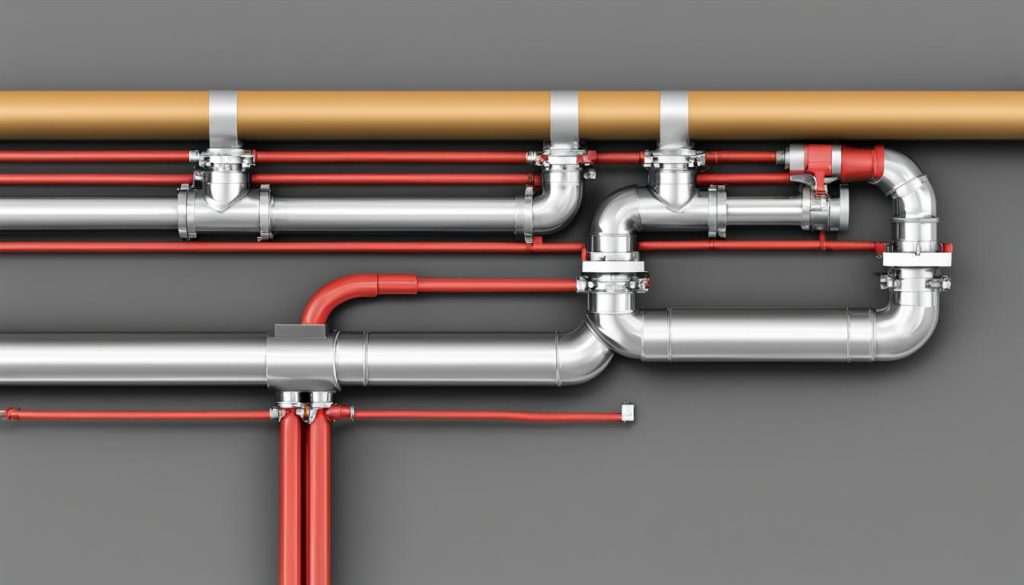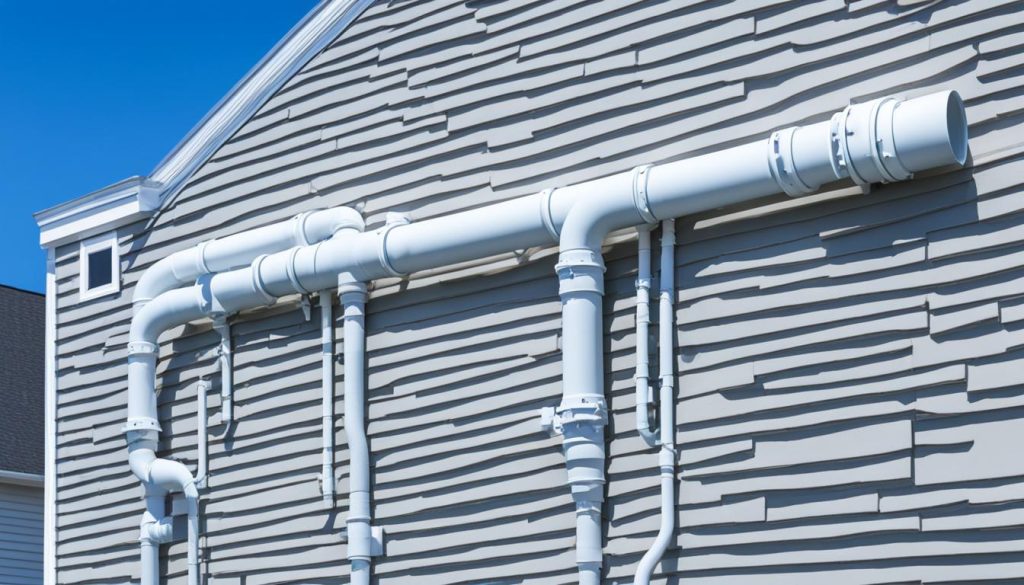Plumbing Vent Elbow Limits: How Many Can You Use?
In the world of plumbing, even the smallest details can make a big difference. One often overlooked aspect is the configuration of plumbing vents. Did you know that the placement of elbows in vent pipes can have a significant impact on the efficiency and functionality of your plumbing system? It’s true!
According to code requirements, for plumbing vents longer than 40 feet (12,192 mm), the pipe size must increase by one nominal pipe size for the entire length. However, when it comes to bending vent pipes at 90 degrees, it is recommended to avoid sharp, 90-degree elbows below the waterline. These elbows, known as Vent Elbows or Vent Shoulders, can cause issues with venting and drainage. It is important to ensure that vent pipes are vertically straight to prevent vapor locks and allow fresh air into the plumbing system.
Key Takeaways:
- Plumbing vent configuration plays a crucial role in the efficiency and functionality of your plumbing system.
- Avoid sharp, 90-degree elbows below the waterline to prevent venting and drainage issues.
- Ensure that vent pipes are vertically straight to prevent vapor locks and promote proper air circulation.
- For longer vent pipes, the pipe size should increase one nominal pipe size for the entire length.
- By understanding plumbing vent elbow limits, you can optimize the airflow and venting in your plumbing system.
Maximum Number of Elbows in Plumbing Vent
When it comes to determining the maximum number of elbows in a plumbing vent, there is no specific limit set by code requirements. However, it is important to consider plumbing vent elbow guidelines and minimize the number of bends in vent pipes to prevent potential obstructions and airflow restrictions.
Excessive bends in vent pipes, especially in longer vent systems, can impede proper venting and ventilation. To ensure optimal airflow and prevent potential issues with vent obstruction, it is advisable to keep the number of elbows to a minimum.
By following plumbing vent elbow guidelines and taking steps to minimize the number of elbows, you can maintain the efficiency and functionality of your plumbing system. This not only helps to prevent obstructions but also ensures a steady and adequate flow of air throughout the system, allowing for proper drainage and ventilation.
When designing your plumbing vent system, it is essential to consider the overall configuration and layout of the pipes. Plan the positioning of the elbows strategically to avoid unnecessary bends and potential obstacles that may hinder proper airflow.
Preventing Vent Obstruction
To prevent potential issues with vent obstruction, consider the following guidelines:
- Minimize the number of elbows: As mentioned earlier, keeping the number of elbows to a minimum helps to promote optimal airflow and prevents potential obstructions in the vent system.
- Use wide-radius elbows: Wide-radius elbows are preferred over sharp, 90-degree elbows below the waterline. These wider bends allow for smoother air and water flow, reducing the risk of blockages.
- Ensure proper installation: Properly installing vent pipes vertically and straight helps to prevent the accumulation of moisture and the formation of vapor locks. It also facilitates the entry of fresh air into the plumbing system.
| Elbow Type | Advantages | Disadvantages |
|---|---|---|
| Wide-radius elbows | Allow for smoother air and water flow | Require more space for installation |
| Sharp, 90-degree elbows below the waterline | Save space in tight installations | Increase the risk of blockages |
To visually illustrate the advantages and disadvantages of different elbow types, refer to the table below:
https://www.youtube.com/watch?v=0L7yUrcsXeo
By adhering to plumbing vent elbow guidelines and considering the prevention of vent obstruction, you can ensure the optimal performance and longevity of your plumbing system.
Ensuring Proper Venting with Elbows
Proper venting in a plumbing system is crucial for efficient operation. When installing elbows in vent pipes, it is essential to consider design considerations to ensure proper venting and ventilation. By following these guidelines, you can maintain optimal airflow and prevent potential issues in your plumbing system.
Vertical and Straight Installation
One important design consideration is to install vent pipes vertically and straight. This is necessary to prevent moisture accumulation and the formation of vapor locks. When vent pipes are not installed vertically, they can collect condensation, which may lead to blockages and hinder proper venting. By ensuring vertical and straight installation, you can improve the overall performance of your plumbing system.
Wide-Radius Elbows
Another essential consideration is the use of wide-radius elbows. Wide-radius elbows have a gentler bend compared to tight 90-degree elbows. Using wide-radius elbows decreases the likelihood of obstructions and improves water flow within the vent pipes. By allowing for smoother water movement, wide-radius elbows ensure proper venting and reduce the risk of clogs in the system.
Avoiding Tight 90-Degree Elbows Below the Waterline
Tight 90-degree elbows below the waterline can impede proper venting and cause potential obstructions. It is advisable to avoid using these types of elbows in vent pipe installations. Instead, opt for wide-radius elbows or other solutions that maintain consistent water flow. By doing so, you can ensure effective venting and minimize the risk of plumbing issues.
| Design Consideration | Benefits |
|---|---|
| Vertical and Straight Installation | Prevents moisture accumulation and vapor locks |
| Wide-Radius Elbows | Improves water flow and reduces obstructions |
| Avoiding Tight 90-Degree Elbows | Maintains consistent water flow and prevents obstructions |
Venting Plumbing Out the Side of Your House
In most cases, when it comes to venting plumbing, the standard practice is to install vents on the roof. This allows gas to rise above the dwelling and escape safely. However, there may be situations where installing vents on the roof is not feasible. In such cases, an alternative option is to vent plumbing out the side of your house.
When venting plumbing out the side of your house, it is crucial to ensure proper venting to maintain the functionality and safety of your plumbing system. The vent must be positioned at least six inches above the roofline to allow unrestricted airflow and prevent any potential obstructions.
It is important to note that venting plumbing out the side of your house should always comply with local building codes and regulations. These regulations are in place to ensure the safe and efficient operation of your plumbing system.
Before opting for this alternative venting method, consult with a licensed plumber to assess the feasibility and compliance of venting plumbing out the side of your house. They will be able to guide you through the process and ensure that all necessary precautions are taken.
Pros and Cons of Venting Plumbing Out the Side of Your House
| Pros | Cons |
|---|---|
| Alternative option when roof venting is not feasible | Potential for vent obstructions if not properly designed and installed |
| Allows for fresh air intake and proper venting | Compliance with local building codes and regulations is essential |
| Can be visually appealing and less obtrusive compared to roof vents | Requires careful planning and consideration of vent placement |
| May be more cost-effective in certain situations | Consultation with a licensed plumber is recommended |
While venting plumbing out the side of your house may be a viable option, it is essential to weigh the pros and cons and make an informed decision that aligns with your specific circumstances. Working with a professional plumber throughout the process will ensure that your plumbing system functions optimally and adheres to the necessary regulations.
Conclusion – Understanding Plumbing Vent Elbow Limits
Understanding the limits and guidelines for plumbing vent elbows is crucial for ensuring optimal airflow and venting in your plumbing system. While there is no specific limit on the number of elbows a plumbing vent can have, it is important to follow code requirements and design considerations.
Minimizing the number of bends in your vent pipes is recommended to prevent potential obstructions and airflow restrictions. Using wide-radius elbows and avoiding sharp 90-degree elbows below the waterline can help maintain consistent water flow and prevent any potential issues with vent obstruction.
By ensuring proper venting with elbows, you can maintain the efficiency and functionality of your plumbing system. Keep the vent pipes vertically straight to prevent vapor locks and allow fresh air into the plumbing system. This will promote smooth drainage and help prevent moisture accumulation, ensuring your plumbing system operates optimally.
Source Links
- https://24plumberdenver.com/plumbing-elbows-vent/
- https://waypointinspection.com/can-a-vent-stack-have-bends-in-it/
- https://www.diychatroom.com/threads/limit-on-turns-in-vent-stack.67103/
- Investing Wisely: How Windows & Doors in Boost Property Value and Financial Health - April 24, 2025
- The Financial Impact of Personal Injuries: Why Legal Help Matters for Business Owners - April 16, 2025
- The Hidden Financial Costs of Domestic Assault: What Business Owners Need to Know - April 16, 2025













